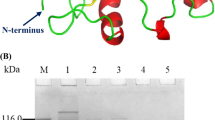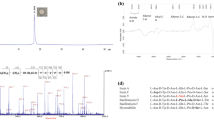Abstract
The use of antimicrobial peptides (AMPs) as biopreservative to replace chemical preservatives has become of interest among consumers. Current approaches of production and purification of AMPs are time-consuming and costly and may kill the producing host cells. In this study a recombinant peptide was patterned from Lasioglossin LL ΙΙΙ which is found naturally in the venom of eusocial bee, this recombinant peptide was produced to inhibit food microbial degradation with the least possible costs. The synthesis of this peptide in the periplasmic space of Escherichia coli, has facilitated the production and purification of this additive. The pET based expression system for production of a recombinant form of Lasioglossin LL ΙΙΙ using E. coli as a host was developed. The antibacterial and antioxidant activities of recombinant peptide were determined. A C-terminal poly histidine tag was used to facilitate purification by standard methods using Ni2+ affinity chromatography. The average yield of the recombinant peptide was 0.7 g/L. The findings showed great antimicrobial function of the peptide. The antioxidant activity of the peptide was lower than Butylated hydroxytoluene (BHT) synthesized antioxidant as a common antioxidant but the antioxidant potential of the peptide along with the antimicrobial activity against foodborne pathogens have shown promising benefits of the peptide. These results demonstrated that pET expression system is appropriate for the rapid and simple isolation of recombinant lasioglossin LL ΙΙΙ from E. coli and the recombinant peptide could be used as a natural preservative source. However, further studies need to be carried out to check the effect of this peptide on more microorganisms.



Similar content being viewed by others
References
Bai W, Wang Q, Zeng X, Fu J, Liu Y, Dong H (2017) Antioxidant activities of chicken peptide-maillard reaction products (CP-MRPS) derived from chicken peptides and d-glucose system. J Food Process Pres 41:e13041
Čeřovský V, Buděšínský M, Hovorka O, Cvačka J, Voburka Z, Slaninová J, Borovičková L, Fučík V, Bednárová L, Votruba IJC (2009) Lasioglossins: three novel antimicrobial peptides from the venom of the eusocial bee Lasioglossum laticeps (Hymenoptera: Halictidae). ChemBioChem 10:2089–2099
Choi J, Lee S (2004) Secretory and extracellular production of recombinant proteins using Escherichia coli. Appl Microbiol Biotechnol 64:625–635
de Arauz LJ, Jozala AF, Mazzola PG, Penna TCV (2009) Nisin biotechnological production and application: a review. Trends Food Sci Technol 20:146–154
del Olmo A, Calzada J, Nuñez M (2017) Benzoic acid and its derivatives as naturally occurring compounds in foods and as additives: uses, exposure, and controversy. Crit Rev Food Sci Nutr 57:3084–3103
Ebbensgaard A, Mordhorst H, Overgaard MT, Nielsen CG, Aarestrup FM, Hansen EB (2015) Comparative evaluation of the antimicrobial activity of different antimicrobial peptides against a range of pathogenic bacteria. PLoS ONE 10:e0144611
Gutierrez J, Barry-Ryan C, Bourke PJI (2008) The antimicrobial efficacy of plant essential oil combinations and interactions with food ingredients. Int J Food Microbiol 124:91–97
Hassan M, Kjos M, Nes I, Diep D, Lotfipour F (2012) Natural antimicrobial peptides from bacteria: characteristics and potential applications to fight against antibiotic resistance. J Appl Microbiol 113:723–736
Hintz T, Matthews KK, Di R (2015) The use of plant antimicrobial compounds for food preservation. Biol Med Res. https://doi.org/10.1155/2015/246264
Ilić N, Novković M, Guida F, Xhindoli D, Benincasa M, Tossi A, Juretić D (2013) Selective antimicrobial activity and mode of action of adepantins glycine-rich peptide antibiotics based on anuran antimicrobial peptide sequences. Biochim Biophys Acta 1828:1004–1012
Joo H-S, Fu C-I, Otto M (2016) Bacterial strategies of resistance to antimicrobial peptides. Philos Trans R Soc B 371:20150292
Kraszewska J, Beckett MC, James TC, Bond UJA, Microbiology E (2016) Comparative analysis of the antimicrobial activities of plant defensin-like and ultrashort peptides against food-spoiling bacteria. Appl Environ Microbiol 82:4288–4298
Lee M-T, Sun T-L, Hung W-C, Huang HW (2013) Process of inducing pores in membranes by melittin. Proc Natl Acad Sci USA 110:14243–14248
Li X, Shi X, Jin Y, Ding F, Du Y (2013) Controllable antioxidative xylan–chitosan Maillard reaction products used for lipid food storage. Carbohyd Polym 91:428–433
Li Q, Montalban-Lopez M, Kuipers OP (2018) Increasing the antimicrobial activity of nisin-based lantibiotics against Gram-negative pathogens. Appl Environ Microbiol 84:e00052
Maekawa A, Ogiu T, Onodera H, Furuta K, Matsuoka C, Ohno Y, Odashima SJF, Toxicology C (1982) Carcinogenicity studies of sodium nitrite and sodium nitrate in F-344 rats. Food Chem Toxicol 20:25–33
Malik A, Alsenaidy AM, Elrobh M, Khan W, Alanazi MS, Bazzi MD (2016) Optimization of expression and purification of HSPA6 protein from Camelus dromedarius in E. coli. Saudi J Biol Sci 23:410–419
Melvin P, Weinstein M, Jean B et al (2009) Methods for dilution antimicrobial susceptibility tests for bacteria that grow aerobically; approved standard, 11th edn. Clinical and Laboratory Standards Institute (CLSI), Wayne
Mergulhao F, Summers DK, Monteiro GAJBA (2005) Recombinant protein secretion in Escherichia coli. Biotechnol Adv 23:177–202
Mishra B, Basu A, Saravanan R, Xiang L, Yang LK, Leong SSJ (2013) Lasioglossin-III: antimicrobial characterization and feasibility study for immobilization applications. RSC Adv 3:9534–9543
Murby M, Uhlén M, Ståhl S (1996) Upstream strategies to minimize proteolytic degradation upon recombinant production in Escherichia coli. Protein Expr Purif 7:129–136
Mursalat M, Rony AH, Rahman A, Islam N, Khan MSJI (2013) A critical analysis of artificial fruit ripening: scientific, legislative and socio-economic aspects. ChE Thoughts 6:9
Okuda D, Yomogida S, Kuwahara-Arai K, Hitamatsu K, Tamura H, Nagaoka I (2009) Augmentation of the antimicrobial activities of guinea pig cathelicidin CAP11-derived peptides by amino acid substitutions. Int J Mol Med 23:501–508
Pandey H, Kumar V, Roy BJTR (2014) Assessment of genotoxicity of some common food preservatives using Allium cepa L. as a test plant. Toxicol Rep 1:300–308
Parisien A, Allain B, Zhang J, Mandeville R, Lan CJ (2008) Novel alternatives to antibiotics: bacteriophages, bacterial cell wall hydrolases, and antimicrobial peptides. J Appl Microbiol 104:1–13
Pascariu M, Anghelache AN, Constantinescu D, Jitaru D, Carasevici E, Luchian T (2011) The evaluation of biological effect of cytotoxic peptides on tumor cell lines. Dig J Nanomater Biostruct 7:79–84
Peng X, Kong B, Xia X, Liu Q (2010) Reducing and radical-scavenging activities of whey protein hydrolysates prepared with Alcalase. Int Dairy J 20:360–365
Pihlanto A (2006) Antioxidative peptides derived from milk proteins. Int Dairy J 16:1306–1314
Rajapakse N, Mendis E, Byun H-G, Kim S-K (2005) Purification and in vitro antioxidative effects of giant squid muscle peptides on free radical-mediated oxidative systems. J Nutr Biochem 16:562–569
Rao M, Chawla S, Chander R, Sharma A (2011) Antioxidant potential of Maillard reaction products formed by irradiation of chitosan–glucose solution. Carbohyd Polym 83:714–719
Richard C, Drider D, Elmorjani K, Marion D, Prévost H (2004) Heterologous expression and purification of active divercin V41, a class IIa bacteriocin encoded by a synthetic gene in Escherichia coli. J Bacteriol 186:4276–4284
Saidi S, Deratani A, Belleville M-P, Amar RB (2014) Antioxidant properties of peptide fractions from tuna dark muscle protein by-product hydrolysate produced by membrane fractionation process. Food Res Int 65:329–336
Sambrook J, Fritsch EF, Maniatis T (1989) Molecular cloning: a laboratory manual. Cold Spring Harbor Laboratory Press, New York
Scocchi M, Mardirossian M, Runti G, Benincasa M (2016) Non-membrane permeabilizing modes of action of antimicrobial peptides on bacteria. Curr Top Med Chem 16:76–88
Sockolosky JT, Szoka FC (2013) Periplasmic production via the pET expression system of soluble, bioactive human growth hormone. Protein Expr Purif 87:129–135
Studier FW (1990) Use of T7 RNA polymerase to direct expression of cloned genes. Methods Enzymol 185:60–89
Tajkarimi M, Ibrahim SA, Cliver D (2010) Antimicrobial herb and spice compounds in food. Food Control 21:1199–1218
Tanhaeian A, Ahmadi FS, Sekhavati MH, Mamarabadi M (2018) Expression and purification of the main component contained in camel milk and its antimicrobial activities against bacterial plant pathogens. Probiotics Antimicrob Proteins 10:787–793
Tanhaiean A, Azghandi M, Razmyar J, Mohammadi E, Sekhavati MH (2018) Recombinant production of a chimeric antimicrobial peptide in E. coli and assessment of its activity against some avian clinically isolated pathogens. Microb Pathog 122:73–78
Toaima W, Trak J, Alkowwatly K (2015) Nisin peptide as promising natural food preservative for food. J Chem Pharm Res 4:31–36
Toke O (2005) Antimicrobial peptides: new candidates in the fight against bacterial infections. Pept Sci 80:717–735
Uhlig T, Kyprianou T, Martinelli FG, Oppici CA, Heiligers D, Hills D, Calvo XR, Verhaert P (2014) The emergence of peptides in the pharmaceutical business: from exploration to exploitation. EuPA Open Proteom 4:58–69
van de Loosdrecht AA, Nennie E, Ossenkoppele GJ, Beelen RH, Langenhuijsen MM (1991) Cell mediated cytotoxicity against U 937 cells by human monocytes and macrophages in a modified colorimetric MTT assay: a methodological study. J Immunol Methods 141:15–22
Vhangani LN, van Wyk J (2013) Antioxidant activity of Maillard reaction products (MRPs) derived from fructose–lysine and ribose–lysine model systems. Food Chem 137:92–98
Wang Q, Zhu F, Xin Y, Liu J, Luo L, Yin Z (2011) Expression and purification of antimicrobial peptide buforin IIb in Escherichia coli. Biotechnol Lett 33:2121
Wang S, Zeng X, Yang Q, Qiao S (2016) Antimicrobial peptides as potential alternatives to antibiotics in food animal industry. Int J Mol Sci 17:603
Wiegand I, Hilpert K, Hancock RE (2008) Agar and broth dilution methods to determine the minimal inhibitory concentration (MIC) of antimicrobial substances. Nat Protoc 3:163
Wiriyaphan C, Xiao H, Decker EA, Yongsawatdigul J (2015) Chemical and cellular antioxidative properties of threadfin bream (Nemipterus spp.) surimi byproduct hydrolysates fractionated by ultrafiltration. Food Chem 167:7–15
Yoon SH, Kim SK, Kim JF (2010) Secretory production of recombinant proteins in Escherichia coli. Recent Pat Biotechnol 4:23–29
Zhang N, Lan W, Wang Q, Sun X, Xie J (2018) Antibacterial mechanism of Ginkgo biloba leaf extract when applied to Shewanella putrefaciens and Saprophytic staphylococcus. Aquac Fish 3:163–169
Zhao J, Zhao C, Liang G, Zhang M, Zheng JI (2013) Engineering antimicrobial peptides with improved antimicrobial and hemolytic activities. J Chem Inf Model 53:3280–3296
Acknowledgements
We hereby acknowledge Department of Food Science and Technology, Faculty of Agriculture, Ferdowsi University of Mashhad for providing us with all facilities and financial supports required to perform the practical work.
Funding
This study was funded by the deputy of Research and Technology, Ferdowsi University of Mashhad, Iran (Grant No: 2/45804).
Author information
Authors and Affiliations
Corresponding author
Ethics declarations
Conflict of interest
The authors declare there is no conflict of interest.
Ethical Approval
This article does not contain any studies with human participants or animals performed by any of the authors.
Additional information
Publisher's Note
Springer Nature remains neutral with regard to jurisdictional claims in published maps and institutional affiliations.
Rights and permissions
About this article
Cite this article
Tanhaeian, A., Habibi Najafi, M.B., Rahnama, P. et al. Production of a Recombinant Peptide (Lasioglossin LL ΙΙΙ) and Assessment of Antibacterial and Antioxidant Activity. Int J Pept Res Ther 26, 1021–1029 (2020). https://doi.org/10.1007/s10989-019-09904-5
Accepted:
Published:
Issue Date:
DOI: https://doi.org/10.1007/s10989-019-09904-5




